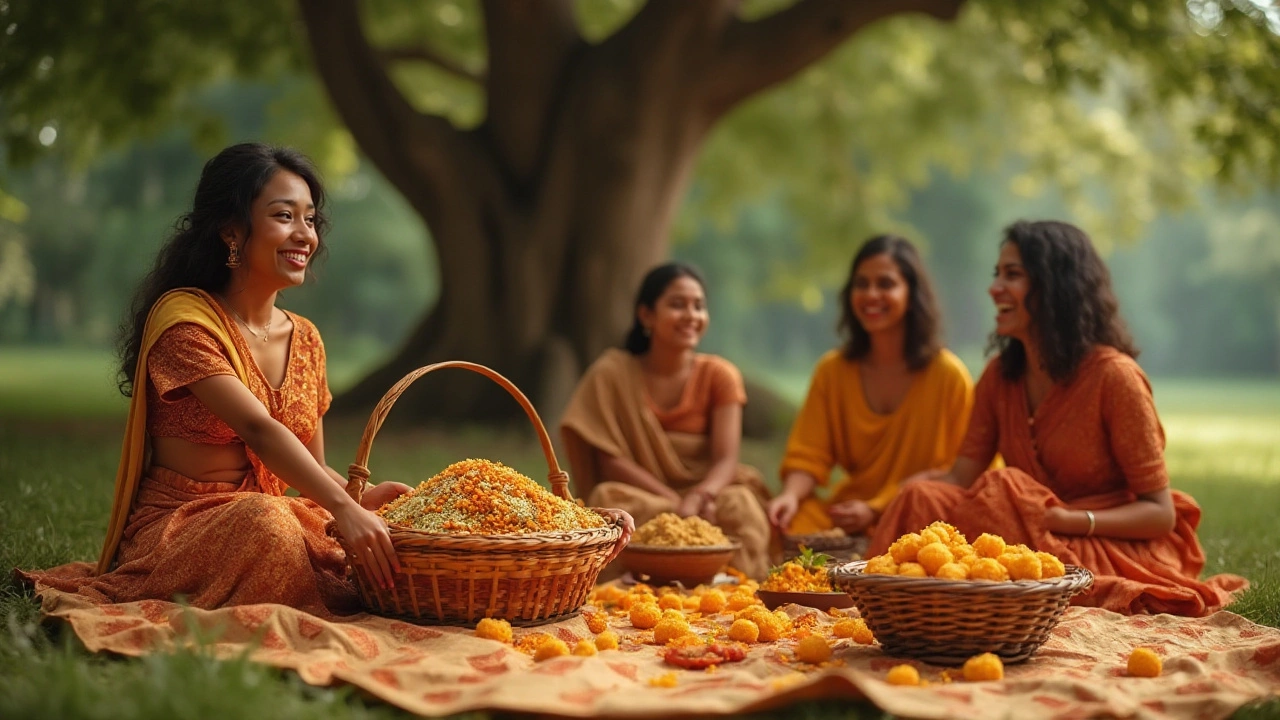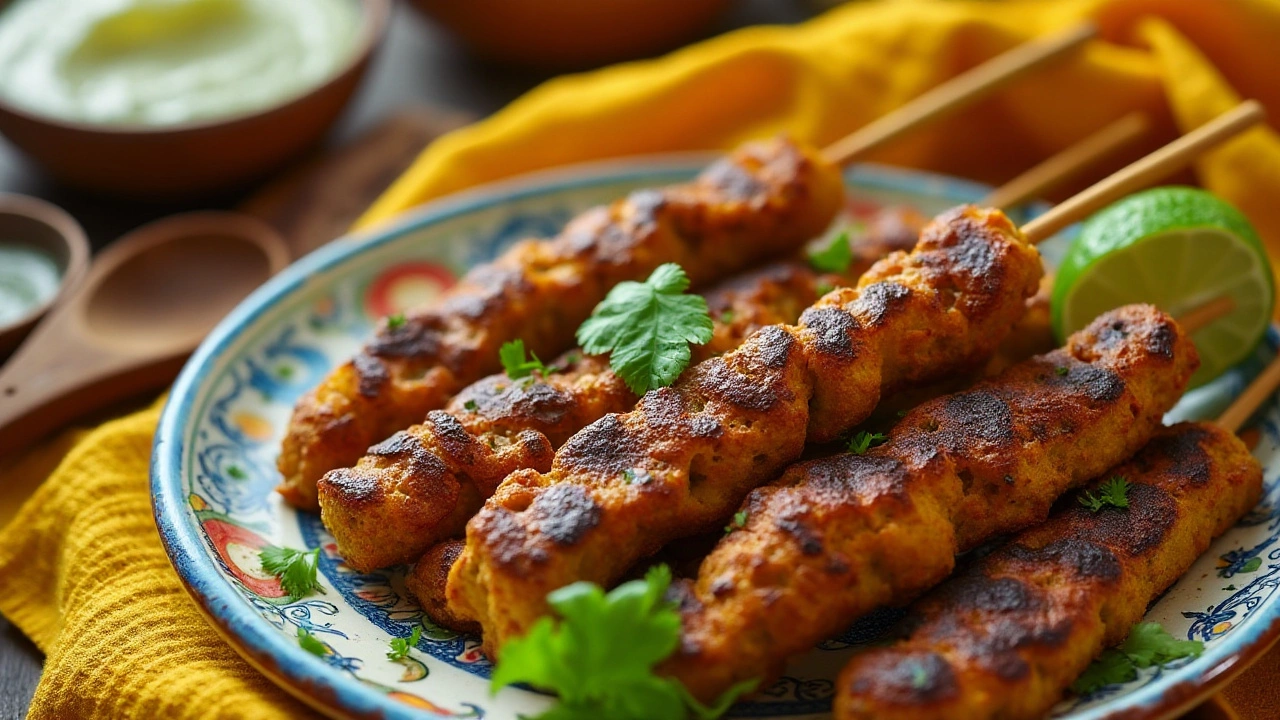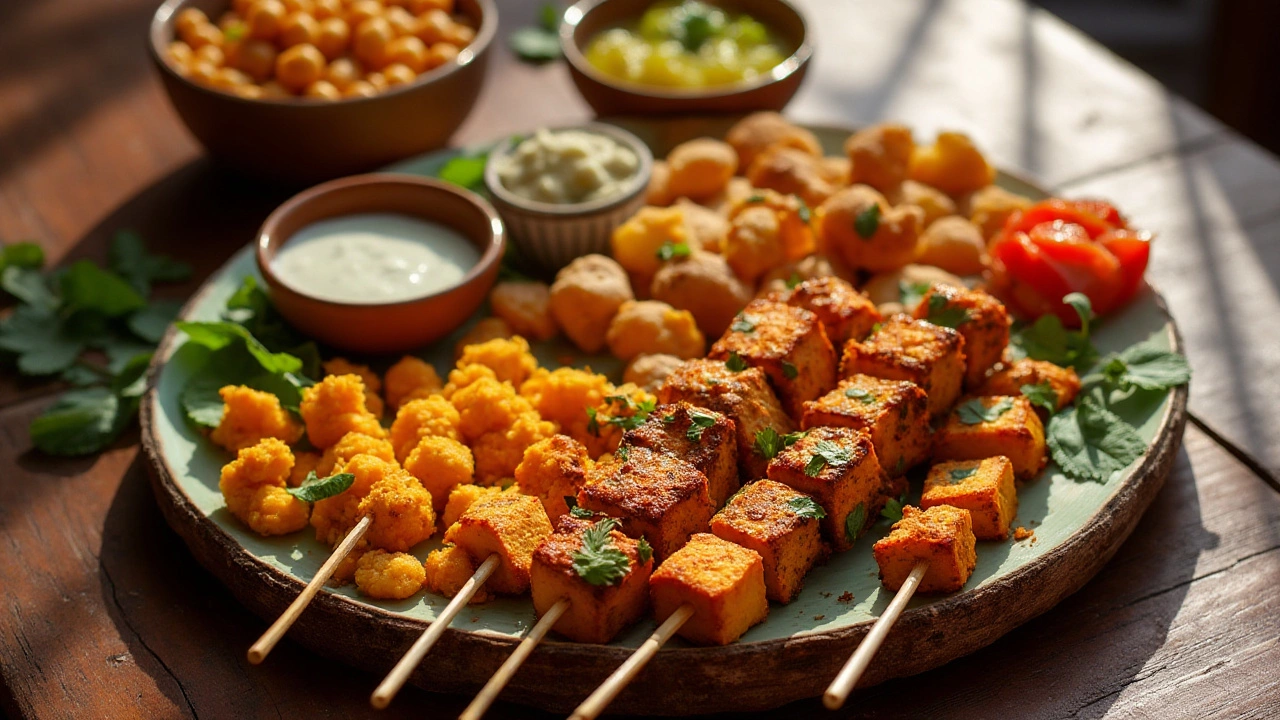When it comes to snacking, getting the most nutritional bang for your calorie buck is important, especially if you’re trying to increase your protein intake. Indian cuisine offers a variety of snacks that can do just that — provide you with 30 grams of protein or more, all the while keeping things interesting and flavorful.
While traditional snacks often rely on rich spices and wholesome ingredients, you can now find or easily create versions that focus on maximizing protein content. Think of everything from chickpea flour-based goodies to snacks infused with nuts and seeds. These protein-heavy bites not only satiate your hunger but also support your fitness or health goals.
- Importance of Protein in Snacks
- Traditional High-Protein Indian Ingredients
- Modern Twists on Classic Snacks
- Recipes for Protein-Packed Snacks
- Tips for Incorporating Protein-Rich Snacks
Importance of Protein in Snacks
In today's fast-paced world, finding healthy snacks that also cater to our nutritional needs can be a challenge. High-protein snacks, particularly those rooted in traditional Indian foods, are becoming increasingly significant for a variety of reasons. Protein, being one of the essential macronutrients, plays a critical role in our body. It not only aids in building and repairing muscles but also is vital for making enzymes and hormones. Incorporating sufficient protein into one’s diet helps with increasing muscle mass, enhancing bone health, and promoting satiety, which is the feeling of fullness after eating. This is why many nutritionists recommend integrating protein throughout the day, including snack times.
When speaking of Indian snacks, one must imagine a plethora of flavors, aromas, and textures. These snacks, often celebrated for their use of spices and vibrant tastes, can also boast impressive protein values. For those who lead a busy lifestyle, having access to snacks that are not only tasty but also nutritious is imperative. High-protein Indian snacks offer a savory retreat while supporting your body's daily protein requirements. In a culture where vegetarianism is prevalent, legumes, dairy, and seeds become essential sources of protein. These ingredients, when incorporated smartly, can lead to an exciting array of delicious, protein-packed treats that can effectively fuel your day without compromising your health goals.
Many might wonder just how much protein should be included in a snack. While typical recommendations suggest a distribution of protein intake throughout the day, aiming for snacks that offer around 15-30 grams of protein can be ideal for managing hunger and maintaining energy levels. This approach helps in stabilizing blood sugar levels, bolstering metabolism, and ensuring that protein synthesis remains effective. According to registered dietitians, "Integrating protein into your snacks can help you meet your fitness and health goals without feeling deprived," which resonates with those looking to balance indulgence with nutrition.
To underscore the importance of Indian snacks in contributing to one's protein goals, let's delve into some of the most potent ingredients utilized. Lentils, chickpeas, paneer, and nuts are dietary staples that not only enhance the flavor profile but offer high nutritional value. These ingredients have been cherished for centuries in Indian households for their versatility and nutrient density. Considering the increasing global interest in plant-based eating, these native ingredients are also finding their place in contemporary culinary practices, thus reaffirming their significance across diverse dietary preferences.
The journey to increasing protein intake through snacking need not be tedious or bland. Instead, it can be an exploration of culinary heritage fused with health benefits. With the variety offered by Indian cuisine, individuals can enjoy flavorful snacks that support their nutritional needs. Whether you opt for a traditional chana chaat or a modern quinoa upma, there is always a way to integrate high-protein snacks into your meal plan. A little creativity paired with knowledge about ingredient nutrition can go a long way in achieving a balanced diet that prioritizes protein intake during snack times.
Traditional High-Protein Indian Ingredients
Indian cuisine has a rich tapestry of ingredients that are not only delicious but also nutritionally rewarding. Many traditional ingredients are excellent sources of protein and form the backbone of numerous high-protein snacks. Legumes and pulses like chickpeas, lentils, and black gram, collectively known as 'dal,' are staples in Indian households. Chickpeas, in particular, are versatile and can be roasted, ground into flour for snacks like besan chilla, or mixed into salads, offering substantial protein content. Lentils are another powerhouse and often come in various forms suitable for making spicy fritters and nourishing soups.
Nuts and seeds also play an essential role in the Indian diet. Almonds, cashews, and peanuts not only add a wonderful crunch but are packed with protein, healthy fats, and beneficial minerals. These can be consumed as is, turned into rich butters, or blended into shakes. They make for an excellent add-on to sweet and savory dishes alike, contributing both flavor and nutrient density. Seeds like flax and sesame are often sprinkled on top of dishes or used in chutneys, providing a quiet but potent protein punch. A little sesame seed goes a long way, offering both calcium and protein in abundance.
Dairy products like paneer (Indian cottage cheese), dahi (yogurt), and ghee are foundational in many regional cuisines. Paneer, with its mild taste and firm texture, can be grilled, sautéed, or added to curries, absorbing flavors beautifully while delivering on the protein front. Dahi is not just a meal component but also a go-to snack in many parts of India. Rich in protein and probiotics, it can be eaten plain, flavored with honey, or mixed into smoothies for a creamy treat.
In the words of celebrated chef Sanjeev Kapoor, "The traditional Indian kitchen is a treasure of ingredients that provide nutrition and taste, catering to both the body and soul."
Soy-based foods, although a newer addition compared to age-old ingredients, have found their rightful place in the modern Indian diet. Textured vegetable protein, known locally as soya nuggets, serves a similar function to meat in vegetarian dishes, absorbing spices and sauces readily. These nuggets are a boon for those looking to add variety to their protein sources. Fermented foods like idli and dosa, made from rice and lentil batter, also make the list. When fermented, they improve protein availability and digestion, making them a breakfast favorite across the nation. These ingredients form the base of many Indian snacks, offering nutrition without compromising on flavor.
Interestingly, ancient grains like amaranth and millet are seeing a renaissance as people become more health-conscious. Used traditionally in rural Indian cooking, these grains are now featured prominently in health-conscious menus. Amaranth, for example, is a complete protein, containing all essential amino acids. Millets like pearl and finger millet are high in protein and are often used to make healthy rotis and porridges. These ingredients connect past and present culinary practices, offering food choices that are both healthy snacks and rich in protein. It's no wonder Indian cuisine, with its wealth of ingredients, continues to adapt and thrive amidst global nutrition trends.

Modern Twists on Classic Snacks
Tradition may be the backbone of culture, but innovation often brings the refreshing change we didn’t know we needed. In the realm of Indian snacks, this means merging time-honored flavors with modern health goals, particularly in the pursuit of high-protein content. Let's explore how some classic snacks have been reimagined to deliver a plentiful protein punch, while still paying homage to their rich heritage. Whether you're looking to tweak recipes or discover new favorites, the realm of healthy snacks is ripe with possibilities.
Take the humble besan chilla, a savory pancake made from chickpea flour. Traditionally served plain or with vegetables, a modern twist involves adding quinoa or amaranth to the batter. Not only do these grains boost the amino acid profile, but they also lend a delightful texture. Garnish it with a dollop of Greek yogurt and sprinkle some hemp seeds on top, and you have a snack that’s rich in both protein and gut-loving probiotics. This is a perfect example of how innovation can enhance both taste and nutrition without straying too far from the original.
Another beloved classic given a modern-day makeover is the beloved paneer tikka. Typically marinated in a spicy yogurt blend and chargrilled, it gains an exciting update by incorporating herbs like basil or mint for a fresh burst and perhaps a squeeze of lime for a zingy finish. An innovative approach is substituting paneer with tofu for those seeking plant-based alternatives, providing a similar texture and a lower-calorie count without sacrificing the protein content. Quinoa kebabs also offer a highly customizable avenue to include seasonal vegetables, which keeps the dish vibrant and fresh year-round.
For those with a sweet tooth, moong dal halwa, traditionally a rich, buttery delight, can undergo a healthy transformation. Replace the clarified butter or ghee with coconut oil for a lighter version, and amp up the protein by adding a scoop of protein powder, such as pea or whey, into the mix. Sweetened with natural alternatives like dates or dried figs, this becomes not just a guilt-free indulgence but a high-protein treat that can satisfy post-workout cravings without a sugar crash.
"Indian cuisine is versatile enough to mold old recipes into new benefits that align with our changing tastes and lifestyles," says culinary expert Meera Sodha, known for her inventive takes on traditional dishes. The integration of these modern twists with traditional elements is where culinary magic truly happens.
Finally, nothing speaks to melding tradition with health like creating protein-rich ladoos, a snack staple of Indian households. Switching up the flour base with almond or spelt flour can add a nutty richness while inherently increasing the protein content. Mixing in crushed nuts like pistachios or almonds, paired with shredded coconut or dried fruit, offers a myriad of textures. The result is a wholesome Indian snack that's particularly delightful during festive seasons but light enough to enjoy any day. This constant dance between the old and the new ensures that taste buds are continually surprised without sacrificing foundational flavors.
Recipes for Protein-Packed Snacks
Creating high-protein snacks that are both tasty and nutritious is not as daunting as it might initially seem. With the rich tapestry of Indian cuisine, there are numerous ingredients that can easily be transformed into delightful bites. Let's explore some simple yet effective recipes that can help you achieve that coveted 30g protein mark while satisfying your cravings.
Chickpea Flour Pancakes
Chickpea flour, also known as besan, is a versatile ingredient that is often underestimated in the world of snacks. To make pancakes, combine a cup of chickpea flour with minced garlic, finely chopped spinach, and an array of spices such as turmeric, cumin, and coriander. A pinch of salt is essential to bring out the flavors. These pancakes are cooked in a non-stick pan with a light layer of oil until golden. Each serving is protein-rich, thanks to the dense nature of chickpea flour.
A great suggestion is to pair these pancakes with a side of thick Greek yogurt, which boosts the protein content and adds a refreshing tanginess that complements the spicy warmth from the pancakes. For an extra dose of protein, sprinkle some sesame or chia seeds on top. As with any recipe, the beauty lies in the balance of textures and flavors, allowing you to enjoy a snack that fuels your day while keeping your taste buds engaged.
Paneer Tikka Skewers
When talking about protein-rich foods, paneer often takes the spotlight in Indian culinary arts. Homemade paneer, marinated in yogurt mixed with vibrant spices like red chili powder, garam masala, and kasuri methi, can be grilled on skewers alongside bell peppers and onions. The skewers are a great option for quick evening cravings, offering a soft, satisfying bite with each piece of paneer.
According to nutritionist Rujuta Diwekar, "Incorporating traditional foods like paneer can make your diet more sustainable and enjoyable over time."
Offering about 30g of protein per serving, these skewers are prefect for days when you're longing for something savory and fulfilling without the carbs. Their smoky aroma and melt-in-mouth texture can be a delightful addition to a casual evening snack or even served as appetizers during festive gatherings, showcasing how nutrition and taste can movie hand in hand.
Sprouted Lentil Salad
Sprouted lentils are little nutrition powerhouses: they are exceedingly easy to include in your diet while offering high levels of protein and fiber. To prepare a sprouted lentil salad, you only need a handful of fresh tomatoes, cucumbers, red onions, and coriander for garnishing. Mix these with boiled sprouted lentils, a dash of lime, and a sprinkle of chaat masala. The blend of crunchy vegetables and the tender bite of lentils creates an explosion of flavors. It is substantial, appealing to the palate, and yet deliciously refreshing at the same time.
The secret behind why this salad works wonders is its versatility—add diced tofu for extra protein or toss in nuts like almonds or walnuts for a crunchy twist. Sprouted lentils provide a significant chunk of protein, easily reaching your dietary goals while being light on your stomach. Embrace these recipes and experience the symphony of taste, health, and traditional Indian cooking wrapped in one.

Tips for Incorporating Protein-Rich Snacks
Navigating the world of protein-rich snacks can be both exciting and daunting. To effectively incorporate them into your routine, it's crucial to understand not only what to include but also how to seamlessly make these snacks a part of your lifestyle. Let's explore some practical steps and insights to help you enhance your diet with delicious high-protein snacks that cater to both taste buds and nutritional necessities.
First and foremost, plan your snacking around your daily schedule. Whether you have a busy day at work or a relaxed weekend at home, having protein-rich snacks on hand can make it easier to avoid unhealthy options. It can be incredibly helpful to prepare these snacks in advance, so consider setting aside some time during the weekend for this task. This way, you ensure a constant supply of wholesome, high-protein fuel without having to make last-minute decisions that often lead to less healthy choices. Keep in mind; it's not just about eating more protein. Balance is key. Pairing these snacks with some healthy carbs and a touch of fats can make them more satisfying and rounded in terms of nutrition.
Next, embrace variety. Relying on the same snack can become monotonous, which might lead you to stray towards less nutritional options. The rich tapestry of Indian snacks offers countless possibilities. Try mixing chickpeas, paneer, and lentils into your snack regime. These ingredients can easily be transformed into hearty bites like roasted chickpeas or paneer skewers. Experimenting with flavors and textures keeps your snacking interesting and helps meet diverse nutrient requirements. Highlighting this point, a noted nutritionist recently remarked,
"Adding variety not only ensures a rounded intake of nutrients but also keeps your meals and snacks exciting."
Additionally, use your snacks as an opportunity to experiment with cooking. You can prepare snacks like sprouted moong chaat or besan chilla, which pack a protein punch. Both are simple enough to whip up in your kitchen and can be adjusted to suit different taste preferences. Cooking your snacks allows you to control portion sizes and ingredients, lending a more wholesome approach to snack time. If you're short on time, options such as Greek yogurt with nuts or protein bars made with Indian spices can be convenient alternatives that don't compromise on nutrition.
Healthy snacks should also be environmentally friendly. Whenever possible, opt for locally sourced ingredients. Not only does this bolster the local economy, but it also ensures freshness and reduces your carbon footprint. Keep an eye on seasonal produce to bring in fresh elements that can complement the protein-rich staples. For instance, cucumber rounds can help refresh and add a crisp texture when paired with paneer or hummus based on chickpeas or moong dal. By incorporating local elements, you contribute to sustainability while still enjoying flavorful snacks.
Lastly, be mindful of portions and listen to your hunger cues. While protein-rich snacks can help keep you full, eating mindfully is important. It's easy to eat more than necessary when distracted, so allocate time specifically for snacking without multitasking. This ritual enhances your relationship with food, emphasizing quality over quantity. A promising way to gauge portion sizes and balance is to use visual cues, ensuring each snack is fulfilling both in terms of hunger and nutritional value. This approach can help prevent overeating and maintain a balanced diet.
